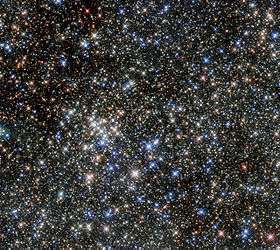V4650 Sagittarii
 V4650 Sgr is the very bright object just off the left edge of this image of the Quintuplet Cluster, with only its diffraction spikes visible. Credit: HST\NIMCOS (WFC3) | |
| Observation data Epoch J2000 Equinox J2000 | |
|---|---|
| Constellation | Sagittarius |
| Right ascension | 17h 46m 17.982s[1] |
| Declination | −28° 49′ 03.46″[1] |
| Characteristics | |
| Evolutionary stage | LBV |
| Apparent magnitude (B) | 19.3[1] |
| Apparent magnitude (R) | 16.4[1] |
| Apparent magnitude (J) | 12.310[1] |
| Apparent magnitude (H) | 8.970[1] |
| Apparent magnitude (K) | 7.090[1] |
| Variable type | LBV[2] |
| Astrometry | |
| Distance | 8,000[3] pc |
| Details[3] | |
| Mass | 46 M☉ |
| Radius | 350 R☉ |
| Luminosity | 1,770,000 L☉ |
| Temperature | 11,300 K |
| Other designations | |
| Database references | |
| SIMBAD | data |
V4650 Sagittarii (qF362) is a luminous blue variable star (LBV) in the constellation of Sagittarius. Located some 25,000 light years away, the star is positioned on the edge of a starburst cluster known as the Quintuplet cluster.
Discovery
.jpg)
V4650 Sgr was first catalogued in 1996 as star 362 in a list of stars in the galactic centre region near the Quintuplet Cluster.[4] The acronym qF is used for stars in the list and so the star name is qF 362. The acronym FMM is also used, hence FMM 362.[5] The LBV nature of qF 362 was not recognised until 1999.[6] It is one of three LBVs close to the Quintuplet Cluster, all highly luminous stars.[7]
V4650 was discovered using infrared telescopes. It is extremely faint at optical wavelengths due to interstellar extinction. The 2MASS survey recorded it at 17th magnitude in red light and 19th magnitude in blue light, while it is a 7th magnitude object in K band infrared.[1]
Properties
V4650 Sgr is calculated to be one of the most luminous stars known, at 1,700,000 L☉. It is considered to be a bona-fide luminous blue variable, although its has not been observed to change temperature from the S Doradus minimum strip to a cooler outburst state.[8] The infrared brightness has varied between magnitude 7.0 and 7.9.[2] It is calculated to have a temperature of 11,300 K and a radius of 350 R☉. Unlike both the two nearby LBVs, V4650 Sgr has no detectable associated nebulosity.[7]
References
- 1 2 3 4 5 6 7 8 Cutri, R. M.; Skrutskie, M. F.; Van Dyk, S.; Beichman, C. A.; Carpenter, J. M.; Chester, T.; Cambresy, L.; Evans, T.; Fowler, J.; Gizis, J.; Howard, E.; Huchra, J.; Jarrett, T.; Kopan, E. L.; Kirkpatrick, J. D.; Light, R. M.; Marsh, K. A.; McCallon, H.; Schneider, S.; Stiening, R.; Sykes, M.; Weinberg, M.; Wheaton, W. A.; Wheelock, S.; Zacarias, N. (2003). "VizieR Online Data Catalog: 2MASS All-Sky Catalog of Point Sources (Cutri+ 2003)". VizieR On-line Data Catalog: II/246. Originally published in: 2003yCat.2246....0C. 2246: 0. Bibcode:2003yCat.2246....0C.
- 1 2 Samus, N. N.; Durlevich, O. V.; et al. (2009). "VizieR Online Data Catalog: General Catalogue of Variable Stars (Samus+ 2007-2013)". VizieR On-line Data Catalog: B/gcvs. Originally published in: 2009yCat....102025S. 1. Bibcode:2009yCat....102025S.
- 1 2 Najarro, F.; Figer, D. F.; Hillier, D. J.; Geballe, T. R.; Kudritzki, R. P. (2009). "Metallicity in the Galactic Center: The Quintuplet Cluster". The Astrophysical Journal. 691 (2): 1816. arXiv:0809.3185
 . Bibcode:2009ApJ...691.1816N. doi:10.1088/0004-637X/691/2/1816.
. Bibcode:2009ApJ...691.1816N. doi:10.1088/0004-637X/691/2/1816. - ↑ Figer, Donald F.; Morris, Mark; McLean, Ian S. (1996). "Hot Stars in the Quintuplet". The Galactic Center. 102: 263. Bibcode:1996ASPC..102..263F.
- ↑ Glass, I. S.; Matsumoto, S.; Carter, B. S.; Sekiguchi, K. (1999). "Luminous variables in the Quintuplet cluster". Monthly Notices of the Royal Astronomical Society. 304: L10. Bibcode:1999MNRAS.304L..10G. doi:10.1046/j.1365-8711.1999.02454.x.
- ↑ Figer, Donald F.; McLean, Ian S.; Morris, Mark (1999). "Massive Stars in the Quintuplet Cluster". The Astrophysical Journal. 514: 202. arXiv:astro-ph/9903281
 . Bibcode:1999ApJ...514..202F. doi:10.1086/306931.
. Bibcode:1999ApJ...514..202F. doi:10.1086/306931. - 1 2 Lau, R. M.; Herter, T. L.; Morris, M. R.; Adams, J. D. (2014). "Nature versus Nurture: Luminous Blue Variable Nebulae in and near Massive Stellar Clusters at the Galactic Center". The Astrophysical Journal. 785 (2): 120. arXiv:1403.5298
 . Bibcode:2014ApJ...785..120L. doi:10.1088/0004-637X/785/2/120.
. Bibcode:2014ApJ...785..120L. doi:10.1088/0004-637X/785/2/120. - ↑ Nazé, Y.; Rauw, G.; Hutsemékers, D. (2012). "The first X-ray survey of Galactic luminous blue variables". Astronomy & Astrophysics. 538: A47. arXiv:1111.6375
 . Bibcode:2012A&A...538A..47N. doi:10.1051/0004-6361/201118040.
. Bibcode:2012A&A...538A..47N. doi:10.1051/0004-6361/201118040.